Solar panels for heating a house: types, how to choose and install them correctly
Technological innovation is really surprising, especially when it comes to the practical side of life. More recently, people did not know the schemes for obtaining profitable energy, which makes it possible to refuse expensive electricity. Agree, now alternative sources are available to everyone and it would be great to use them.
Innovative solar panels for heating a house are gradually, but persistently being introduced into our everyday realities. But before you go to the store for them, you should weigh the pros and cons, otherwise you can purchase a completely inappropriate model. In order to prevent this from happening, we will reveal the secrets of choosing these devices.
In addition, from our material you will learn the design features of solar collectors, as well as find step-by-step instructions for installing solar cells. For ease of perception, the material is accompanied by thematic photographs and videos.
The content of the article:
The principle of using solar energy
Often, faced with the need to install solar panels, a person asks about the feasibility of the enterprise. Because in most cases the percentage of sunny days loses significantly to the same cloudy value.
A similar ratio is typical for the regions of the middle zone, and the climate of the northern regions is characterized by an even greater number of cloudy days.
The insufficient number of sunny days is directly related to the efficiency of the devices that process the energy of the earthly luminary. As a result, exposure to sunlight to the surface of the battery is reduced. This process is called insolation.
Its essence is that any plane, regardless of its purpose, takes on a certain amount of solar energy. In the southern regions, the amount is naturally higher, which makes the installation of solar panels more relevant.
However, as practice shows, the market for technological equipment in the field of solar energy synthesis is constantly improving its products, so modern solar cells in solar panels function well even in areas with a low level of insolation.
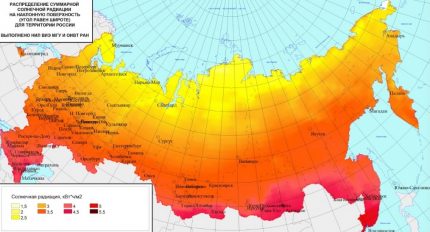
Weighted Installation Approach
Before you organize a solar-powered heating system, you should find out the cons and strengths of the structure, powered by solar energy.
This knowledge is needed to better perceive the differences between equipment and analogues and to evaluate the rationality of the device and assess the feasibility of the construction.
The most significant factors are:
- Efficiency. Real efficiency when converting solar energy into electrical energy. While the energy of solar cells is almost five times more expensive than conventional electricity.
- Seasonality of application. Solar panels will be able to work efficiently only in the absence of obstacles to sunlight, including high cloud cover.
- Weak accumulation scheme. In most cases, the energy received must be consumed immediately. To accumulate and store it, quite voluminous drives are needed, the placement of which will require an impressive area.
- The need for auxiliary energy. In winter, solar panels will not be able to supply enough heat to heat a house. But they can be a useful addition to a heating boiler in case of sunny weather.
- The feasibility of construction. At the moment, the payback of solar panels is much to be desired. Installing them justifies itself only in areas that are not connected to centralized networks. Where there is no alternative to solar devices at all.
There are hopes for the development and production of more affordable solar energy devices. There is confidence that once the construction of systems that process solar energy will become cost-effective.
True, if we take into account that the planet’s energy resources are gradually melting, then we can quite consider solar technology as a profitable, promising investment.
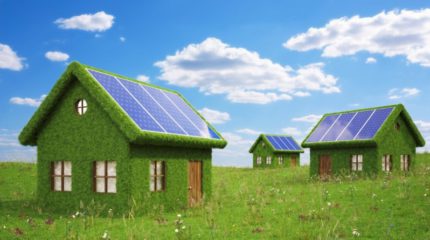
However, now this is only an addition to the main sources of heat, but already has its own set of advantages.
Significant advantages of the solar complex:
- Long period of operation. Constructive simplicity guarantees a minimum of damage. The panels can be accidentally damaged at the time of cleaning from snow, but replacing the glass is quite affordable for making it yourself.
- Wide variety of models. Devices produces a substantial number of foreign companies and individual representatives of domestic manufacturers. Price scatter allows you to choose the option “afford”.
- Individuality settings. The equipment can be configured taking into account all the vagaries of nature in a particular area.
- Cheap energy. More precisely, its complete gratuitousness is a quality that should not be taken literally because of the solid material consumption of the construction of solar panels.
- Outward appeal. Flat heating systems do not violate the architecture of houses, can be perceived as elements of creative design.
We found out that the solar complex can be a help in everyday life, complementing traditional heating sources.In addition, given today's fuel prices, alternative energy contributes to savings, especially in the private sector.
Leading equipment manufacturers, in describing their products, in every possible way emphasize the absolute environmental friendliness system. Naturally, the process of photon energy conversion occurs without the participation of any combustible, toxic, or chemical explosive substances.
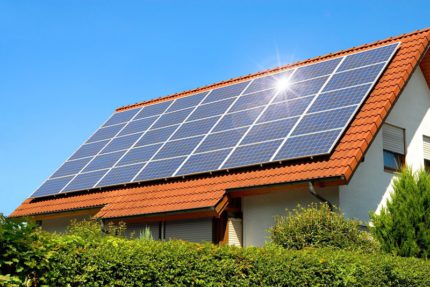
More globally, the widespread use of solar panels will certainly reduce the consumption of other energy sources, such as coal or natural gas. Of course, the situation with the environment in this case will improve qualitatively, and indefatigable bills for heating and combustible materials will remain in the past.
The efficiency of the panels is directly proportional to the amount of absorbed solar energy. But the technological aspect of different types of equipment allows you to increase or decrease productivity.
To increase the system performance, it is recommended to install solar heating in symbiosis with other, more traditional methods of heating.
Do not worry about the fact that the solar collector will very soon fail. The average life of such equipment is about 15 years. The proper functioning of the photocells primarily depends on the region in which the installation is used.
As a rule, the most intense level of insolation puts the system under greater stress. Therefore, if the equipment is used in a temperate climate, it is quite capable of serving more than 15 years.
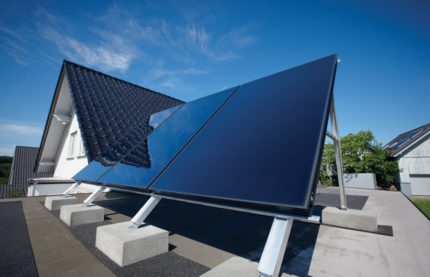
Types of solar complexes
It has been experimentally proven that some substances are able to react more intensively to the effects of photons. Therefore, the technology for manufacturing solar panels is different.
Solar systems for domestic use are divided into 2 dominant types:
- Photoelectric Converters (silicon and film). They are groups of photocells connected in series or parallel to each other, converting solar radiation into electricity. Elements assembled in a single semiconductor system are called solar panel, which supplies energy to electrically dependent heating devices.
- Solar collectors (flat, vacuum or tubular, collector-hubs or mirror). This is the most common type in everyday life, which receives solar energy and transfers it to the heating system in the form of electricity or heated coolant.
In addition to these types, there are solar stations that produce energy on an industrial scale. For private owners, they can serve as a centralized energy supplier.
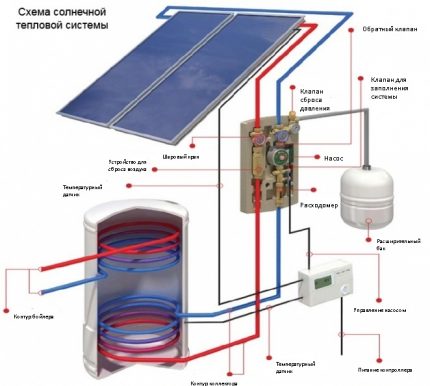
The device of photovoltaic converters
The principle of operation of photovoltaic converters is based on the conversion of solar energy into its electrical type. They are produced in the form of modules on an aluminum frame or on a flexible polymer cloth.
In the first case, the top of the module is protected by high-strength glass, and the bottom by an insulating film. In the second case, both protective shells are made of polymers.
Photovoltaic cells are connected via conductive busbars, the function of which is to transfer energy to a battery or consumer. Contacts are connected to the buses, which serve to connect individual batteries to a complete system and to connect to consumers.
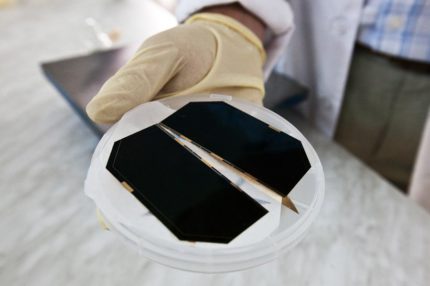
With a focus on the organization of silicon atoms, solar cells are divided into the following categories:
- Monocrystalline. Supplied with the purest silicon, the production technology of which has long been used in the manufacture of semiconductors. The essence of production is the artificial cultivation of a single crystal, which is ultimately cut into 0.2-0.4 mm thick plates. These are the cells of the future battery, which will require 36 pieces.
- Polycrystalline. In the manufacture of wafers are used, obtained from molten silicon after its slow cooling. Technology requires less energy and labor, because solar panels with polycrystals cost much less. Typically, these batteries have a standard bright blue color.
- From amorphous silicon. The technology of their production is focused on the principle of the evaporation phase. As a result of the evaporation process, a thin silicon film settles on the supporting element, which is covered with a transparent protective coating on top. This category of solar panels is called thin-film, installed on the walls of houses.
Monocrystalline batteries are the most productive. Efficiency varies from 14-17% depending on the model and manufacturer. Polycrystalline lose to them by the criteria of efficiency, their efficiency on average 10-12%.
The most inefficient systems are amorphous silicon solar cells. They are designed to process scattered radiation, are installed on the walls of houses as an addition to the more powerful systems located on the roof. Efficiency within 5-6%.
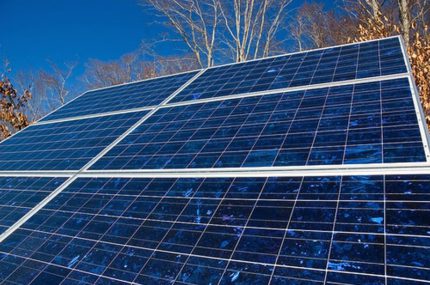
Based on data from leading manufacturers of solar modules such as SunTech Power, it becomes clear that the efficiency of single crystals increases every year, and soon the efficiency can reach about 33%.
However, today the best performance indicators belong to the company's products. Sanyo. The peculiarity of these panels lies in the multilayer nature of the external element, which significantly increases efficiency, and solar collectors is 23%.
Due to the characteristic silicon processing procedure, the polycrystal structure contains undesirable formations that interfere with better absorption of solar energy.
Also, crystalline particles of the microstructure of the module are arranged in a chaotic manner with respect to each other, which complicates the sublimation of energy. As a result, the panel efficiency rarely exceeds 18%.
Sometimes there is a symbiosis of amorphous and poly- / single-crystal reservoirs. This is due to the fact that the normal operation of polycrystals requires intense sunlight, in contrast to amorphous panels. Therefore, the combination of two technologies can be a way out.
There are tangible changes in the production of film systems. So, at the present stage, film films are quite common solar modules based on cadmium and indium.
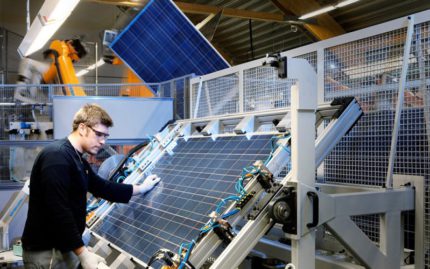
It has been proven that cadmium absorbs sunlight very well, so many manufacturers in the field of solar energy have adopted it. As you know, the substance is radioactive, but you should not worry because of the possibility of exposure, because the proportion of metal is not so large as to cause any harm to the atmosphere, not to mention man.
Indium semiconductor successfully produces 20% efficiency, ahead of cadmium. Due to the fact that indium is much more in demand in household appliances, namely in the production of LCD TVs, manufacturers often replace metal with another analogue - gallium.
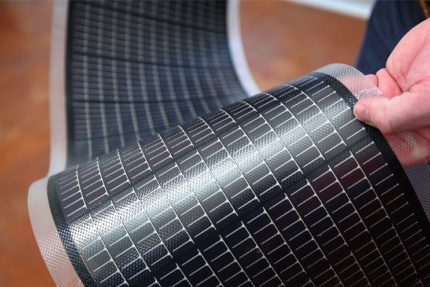
Speaking about the advantages of polymer modules and film collectors as a whole, I would like to highlight a rather low price, compared with crystalline batteries, complete safety and environmental friendliness, due to the stable state of chem. substances. Also, flexibility and versatility can be added to the number of additional advantages.
Design features of solar collectors
The simplest option is a flat solar collector is a box-case, the front side of which is a blackened metal surface. Inside is a coil filled with water, a mixture of water with a non-freezing agent or air.
The bottom and walls of the box are closed by thermal insulation, necessary to save the energy received within the battery.
A metal plate, coupled with tubes, collects and transfers the heated coolant to the heating system. This part is called an absorber. Most often, copper sheet is used for its manufacture, characterized by high thermal conductivity.
The outer side of the adsorber must be intensely black for maximum absorption of solar radiation.
In order to prevent rays from reflecting from the metal surface of the adsorber, a durable transparent coating is installed on top. These are usually tempered glass options with a minimum metal content.
Outside, a special optical coating is applied to it, which does not emit heat in infrared light. It helps to increase the productivity of the device, capable of heating water to 200 ° C.
Tubular panels are sensitive to atmospheric negativity. After heavy rainfall, especially hail, it is recommended to carefully check the integrity of the front cover of the collector.
Blown away by foliage, dusty particles and fragments of branches can also damage the surface. Scratches and chips will cause a sharp deterioration in equipment performance.
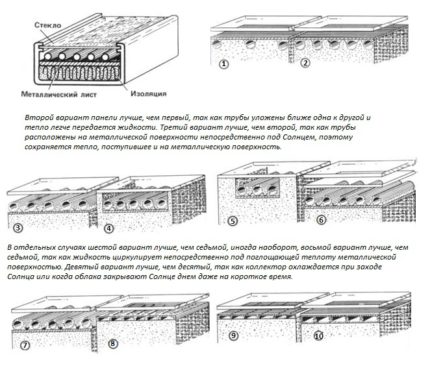
The vacuum version is equipped with a multilayer tube designed according to the principle of a thermos. Such a system allows 95% better than previous models to keep warm.
In the lower part of the multilayer tube there is a liquid, which when heated by the sun turns into steam. A capacitor is mounted at the top of this peculiar sealed bulb. Reaching its steam condenses and transfers heat to the system.
Heliopanels operating according to the vacuum principle are more effective than conventional tubular ones in areas with a small number of sunny days.
Hub collectors are equipped with a device with a mirror surface, which focuses the energy it receives on the surface of the absorber. The area of the mirror is larger than the same size of the absorber, thereby increasing the efficiency of receiving solar energy.
A mirror element can generally be concentrated on a dot or thin line without the slightest loss in performance.
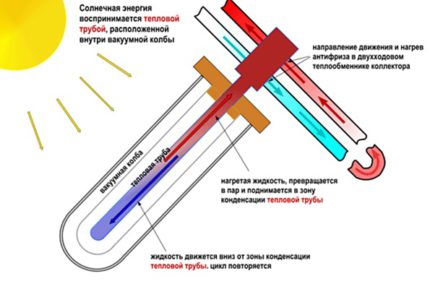
The downside of concentrators is that they can only perceive direct radiation. Therefore, the latest developments are equipped with rotary tracking devices in order to eliminate or reduce the influence of this drawback.
Tracking devices make the collector turn after the movement of the star to collect all its rays.
This is the most effective type of collector solar panels, which allows heating the coolant to a maximum temperature compared to other temperatures. True, they work well in desert areas, they cost a lot, because of which they are mainly demanded by production organizations.
An interesting new solution was the spherical collector design, which captures literally all the rays that it can perceive. It does not need to be equipped with a rotary mechanism, by the way, volatile and requiring connection to the mains.
The spherical design differs from the usual one in that it does not consist of separate tubes connected to the inlet and outlet pipes, but from a single screw heat receiver.
The receiver coil is filled with technical water, which when heated moves up the helical path and exits heated to the outlet pipe, and from there to the heating system.
After cooling, the coolant returns from the heating circuit to the inlet pipe of the spherical collector. The process is repeated.
A significant advantage of the spherical system is that heating occurs throughout the daylight hours. It does not need to be equipped with rotary mechanisms that need power. Thanks to the screw circuit, it is characterized by minimal energy losses in the pipeline.
All types of solar collectors belong to the category of seasonal auxiliary energy production systems. Depending on the model, their internal pipeline can hold up to 200 liters of liquid, and the minimum amount used in vacuum modules is about 60 liters.
To build a solar collector is quite realistic with your own hands. The site has a selection of articles on homemade solar systems.
We advise you to familiarize yourself with:
- How to make a solar collector for DIY heating - step-by-step guide
- How to make a solar battery with your own hands: self-assembly instruction
Installation instructions for solar batteries
Panels belonging to the class of "flat", it is advisable to install in the summer season, when the level of insolation is higher. This will be the best option for the ratio of price and energy received, which means the purchase of such solar collectors fully justify all the money spent.
One way or another, the energy potential of the equipment allows it to be used in hot water and heating systems.
The energy conversion process is extremely sensitive to temperature extremes. This should be considered during installation. First of all, you need to make sure that the home is thoroughly insulated, otherwise unforeseen malfunctions in the system may occur.
For each region, an optimal equipment installation option is provided. The calculation is made on the degree of the same insolation. According to the rules of use, the collector must be positioned so that the angle of incidence of sunlight on its surface is 90 °.
Only in this case the efficiency of the system will be maximum. Absolute accuracy in the installation of panels can be achieved by measuring the latitude of the terrain.
An important factor will be the direction in which the panels are located. Due to the fact that the highest power level is achieved mainly in the middle of the day, it is worth orienting the panels in a southerly direction. Some deviations are allowed during installation, east or west, but not too much.
In addition, often a decrease in efficiency is observed against the background of shadows from trees on the collector panel. In winter, it is recommended to increase the angle of inclination of solar panels, this will improve the level of system performance.
Step 1. Angle selection
The efficiency of the collectors primarily depends on the angle of the panel relative to the horizontal surface. For optimal light absorption It is recommended to maintain a slope of 45 °.
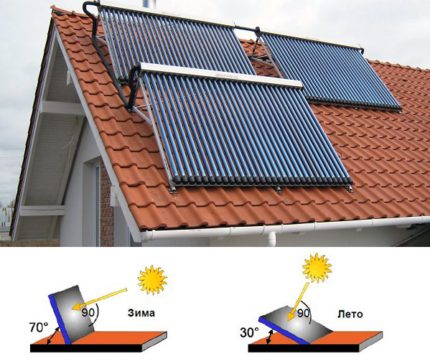
The azimuth must be kept at 0 ° (direct south). Some deviations of 30-40 ° are allowed for better insolation. To increase stiffness, there is a special. aluminum constructions.
This is primarily characteristic of installing collectors on a sloping roof. They will prevent changes in the set parameters due to weather events, and the fast installation speed, using the mounting hooks and profiles, will save time.
Step # 2. Primary circuit construction
At the first stage, all heating components are installed: boilers, compressors, heat conductors, etc. For convenience, it is recommended to place the system elements in an easily accessible place. During installation expansion tank, note the absence of obstacles between it and the collectors.
The temperature inside the tank is measured using a temperature sensor. It should be attached to the bottom of the tank.
The next step will be the organization of a ventilation system. When installing the circuit, you must create air ventcoming out of the expansion tank. The best solution would be to put the communication on the roof. This will contribute to the regulation of pressure drops inside the heating system.
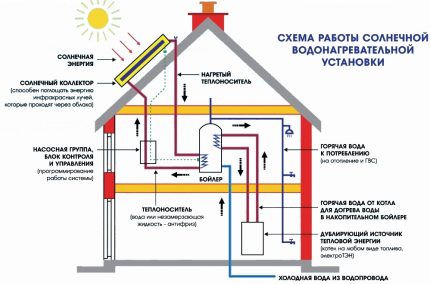
The process of fluid movement inside DHW depends on circulation pump. It is recommended to be used only for systems with a closed type of water circuit. In addition, for the convenience of changing the fluid, the expansion tank should be equipped with a drain system. To do this, fit the crane somewhere in the bottom of the device.
Step # 3. We understand the features of operation
Heliosystem It works from a network of 220 V. Each model has a unique connection scheme, which is supplied.
The wiring must be carefully insulated, and thermostats and all kinds of relays must be located in an exceptionally dry place. For better tightness, it is recommended to protect the equipment with a hydrophobic material.
Be sure to make sure the system is connected to ground. This will protect you from life-threatening situations.
Step # 4. Choosing a way to connect elements
Soldering of copper circuits and electrical parts must be done using a special solder paste. Before this, you need to clean the joints. This is best done with a steel brush.
Elements leading to the distribution tank (pipes, coils) are welded or screwed, previously chopped thread. It is important to understand that a pipe with chilled liquid should approach the bottom of the tank, and with hot - to the top.
Step # 5. Solar installation
Preparatory stage: what needs to be prepared for installation.
The following is the process of installing solar panels.Installation instructions for 2 panels are suitable for mounting any number of solar collectors: the installation principle does not change. The main thing is to find the area for installation.
The last step is system testing.
Additional information on the installation and connection of solar panels is presented in the articles:
- Schemes and methods of connecting solar panels: how to properly install the solar panel
- Connection diagram for solar panels: to the controller, to the battery and to the serviced systems
Conclusions and useful video on the topic
Application of solar panels in autonomous communication systems:
Demonstration of products of one of the leaders in the production of solar batteries:
The principle of design and operation of the vacuum manifold:
Solar systems annually improve performance in the conversion of solar energy. The developers already offer a huge selection of flat and tubular collectors using quartz spraying or single-crystal modules.
All this is gradually updating alternative energy sources, as a result of which solar energy will soon become available to everyone.
Have experience connecting or using solar panels to heat your home? Or have questions about the topic? Please share your opinion, leave comments and participate in discussions. The communication unit is located below.

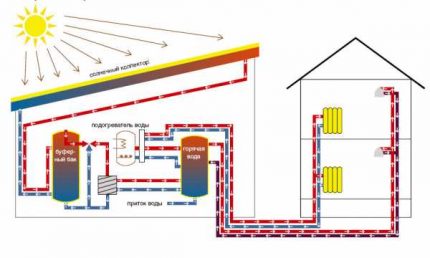
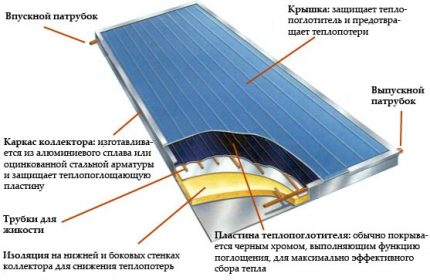
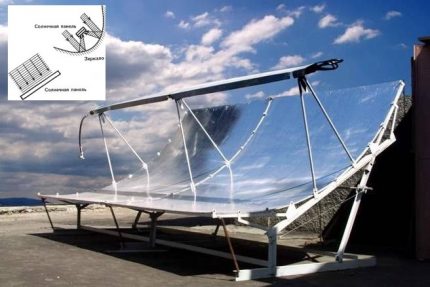
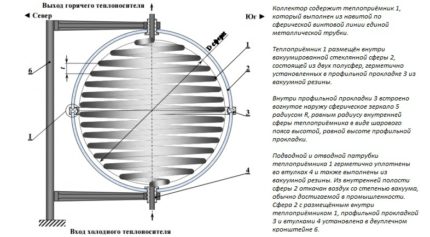
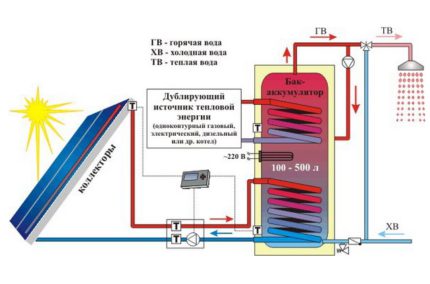
 Solar panels for summer cottages and houses: types, principle of operation and calculation procedure for solar systems
Solar panels for summer cottages and houses: types, principle of operation and calculation procedure for solar systems 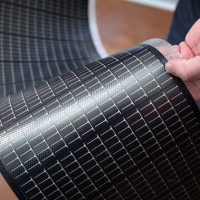 Flexible solar panels: an overview of typical designs, their characteristics and connection features
Flexible solar panels: an overview of typical designs, their characteristics and connection features 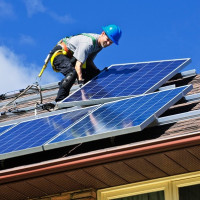 Solar heating systems: analysis of heating technology based on solar systems
Solar heating systems: analysis of heating technology based on solar systems 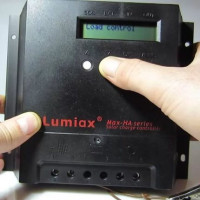 Solar charge controller: circuit, principle of operation, connection methods
Solar charge controller: circuit, principle of operation, connection methods  The principle of operation of the solar battery: how the solar panel is arranged and works
The principle of operation of the solar battery: how the solar panel is arranged and works 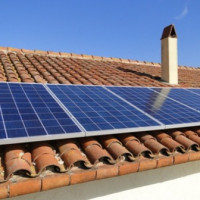 Schemes and methods of connecting solar panels: how to properly install the solar panel
Schemes and methods of connecting solar panels: how to properly install the solar panel  How much does it cost to connect gas to a private house: the price of organizing gas supply
How much does it cost to connect gas to a private house: the price of organizing gas supply  The best washing machines with dryer: model rating and customer tips
The best washing machines with dryer: model rating and customer tips  What is the color temperature of light and the nuances of choosing the temperature of the lamps to suit your needs
What is the color temperature of light and the nuances of choosing the temperature of the lamps to suit your needs  Replacement of a geyser in an apartment: replacement paperwork + basic norms and requirements
Replacement of a geyser in an apartment: replacement paperwork + basic norms and requirements
I love all these eco-gadgets modern! I remember how whole fields with windmills in Germany were struck when I saw them for the first time back in the 90s. Solar panels in everyday life, in the country - it's just my dream! So far I only use it on hikes and on vacation, it helps a lot when I need to recharge the phone.But in order to heat our houses in Russia like this, it seems to me that this is utopia! Still, we do not have sultry Italy here, there is little sun, cloudiness often. Although maybe for the Krasnodar Territory this is an option. And how cool it would be!
Solar panels for heating the cottages - this is my old dream, breaking into harsh reality. Firstly, these panels are not so cheap, and it is not clear when the savings that they seem to give compensate for their cost. And secondly, I’m just scared by the thought of leaving all this stuff unattended for those six months that I haven’t been in the country ... How do these panels tolerate winter frosts? Are there any options with quick assembly / disassembly so that you can remove them when you leave?
The price of the issue now for solar panels and related equipment is quite adequate than, for example, five years ago. Such sources of alternative energy are becoming increasingly available, but putting it in a country house where you will not be visiting for half a year is not prudent. Firstly, someone can “notice” such equipment. Secondly, solar panels need to be cleaned of dust, snow, foliage so that they do not lose their performance.
If you still decide to install solar panels, then they can be mounted in such a way that they can be easily removed before leaving. And you can also come up with a special aluminum frame, for example, with a lock, under which the solar panels will hide for the duration of your absence.
If you install solar panels not on the roof, but on the ground, then you can build any protection against theft, there will no longer be restrictions on the weight of the structure.
Yes, in our age of technology, you no longer have time to follow their development. Ten years ago, my father personally participated in the development of this type of solar panels, but then it was huge heavy tanks, and not just a collector. On our roof, this gigantic construction appeared first in the whole region and barely fit 🙂 Envious people beat it with stones and asked us constantly what it was ... Now somehow everything became more compact, but in my memory, of course, it’s still fresh a cute children's model, assembled by me from cones and such a large can especially for some contest 🙂